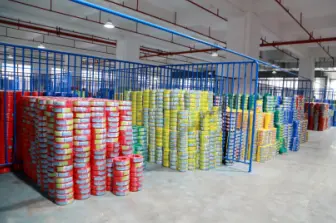What are the applicable occasions and selection requirements for flame-retardant cables?
Flame-retardant cable refers to a cable that, under specified test conditions, when burned, the spread of flames is only within a limited range after removing the test flame source, and any residual flame or smoldering can self-extinguish within a defined time.
1.Flame-retardant cables are suitable for dense cable installations.
The flame-retardant properties of cables with multiple dense configurations should meet the requirements of the appropriate categories based on the "bundle wire and cable burning test method" and the principles of cable configuration, disaster prevention, and economic rationality. Flame-retardant cables should be used.
For the following locations or circuits that need to remain powered under external fire conditions for a certain period of time, such as important circuits for fire protection, alarm, emergency lighting, direct current power supply for breaker operation, and backup power supply for emergency shutdown of generator sets, flame-resistant protection should be implemented or flame-retardant cables with fire resistance should be selected. One of the circuits is the dual-circuit common channel used for computer monitoring, redundant relay protection, and security power supply without mutual isolation.
2.Flame-retardant cables are suitable for exposed cables.
When the number of cables is small, fire-resistant coatings or tapes can be applied to the cables or the cables can be threaded through fire-resistant pipes. When there are more cables in the same channel, it is advisable to lay them in fire-resistant troughs, and breathable-type cables should be used for power cables. In environments without flammable dust, semi-enclosed types can be used. Flame-retardant wraps can also be used for cable protection segments on bridge racks that are not too long.
In other cases where fire resistance is high and installation and economic performance are acceptable, such as oil tank areas, important wooden public buildings, high-temperature locations, etc., flame-retardant cables can be used. For self-contained oil-filled cables that are exposed, such as those laid in public corridors, passenger tunnels, and bridges that require fire protection treatment, sand burial laying can be used. Cable trenches near high-voltage currents, voltage transformers, and other oil-containing equipment should have sealed trench covers.
3.Flame-retardant cables are suitable for dense locations.
In cable-intensive locations or enclosed channels with higher safety requirements, reliable fire automatic detection and alarm devices suitable for the environment should be installed, and flame-retardant cables should be used as well. For the oil supply system of exposed oil-filled cables, fire automatic alarm and interlock devices that can reflect the oil spraying status should be installed. In locations with higher safety requirements, such as densely-cabled areas of underground public facilities, and terminals of multi-return oil-filled cables, special firefighting equipment such as water mist fire extinguishing systems can be installed.
Latest News & Blog
 English
English  français
français  Deutsch
Deutsch  العربية
العربية  tiếng việt
tiếng việt  ไทย
ไทย  čeština
čeština  Indonesia
Indonesia  Eesti
Eesti  български
български  slovenčina
slovenčina 



